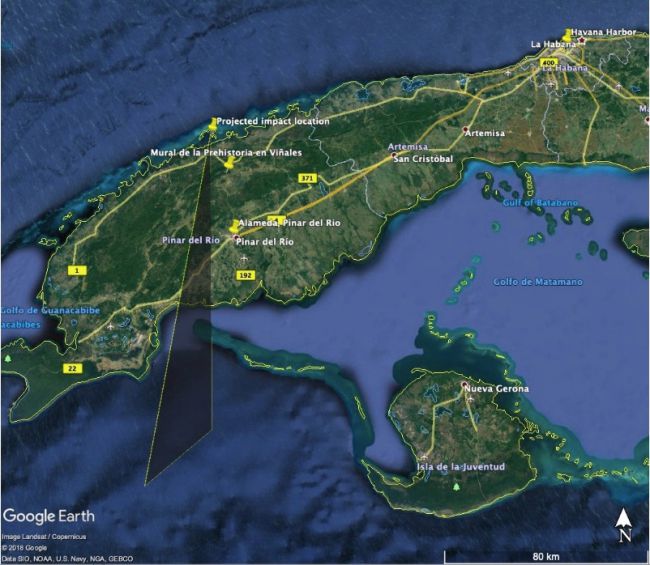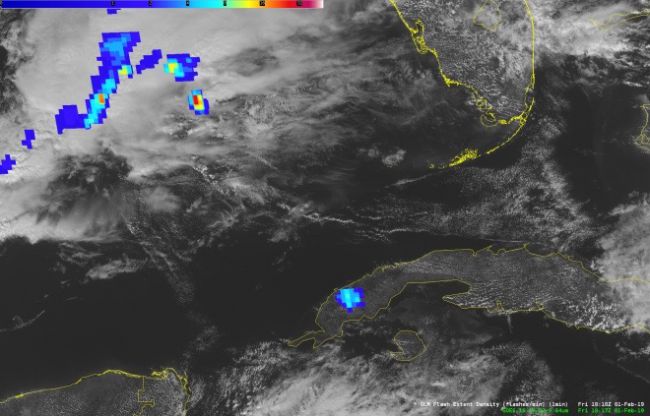Astronomers just got the goods on the meteor that flared up over Cuba earlier this month.
The daytime sky show dazzled thousands of people across western Cuba on Feb. 1. Many of those folks captured footage of the meteor or the trail of debris it left behind when it burned up, permitting the reconstruction of the space rock's path.
"We were very lucky that at least three relatively reliable videos, including one with an incredible quality, could be available on the internet in such a short time," Jorge Zuluaga, a professor at the Institute of Physics (IoP) at the University of Antioquia in Colombia, said in a statement. [How to See the Best Meteor Showers of 2019]
"Reconstructing the trajectory of a meteor requires at least three observers on the ground," Zuluaga added. "Although several satellite images were recorded and also available online, without observations from the ground, the precise reconstruction is not feasible."
Trajectory of the meteor that fell over Cuba on Feb. 1, 2019, as reconstructed by a team of Colombian astronomers. Credit: Zuluaga et al./Google Earth
Zuluaga and his team determined that the meteor entered Earth's atmosphere about 47.5 miles (76.5 kilometers) over the Caribbean Sea, at a point 16 miles (26 km) off Cuba's southwestern coast. At the time, the rock — thought to be a few meters wide and to weigh about 360 tons (330 metric tons) — was traveling roughly 40,300 mph (64,800 km/h), the researchers found.
The meteor moved north-northeast in a relatively straight line. When the object reached an altitude of 17.1 miles (27.5 km), it developed a smoky trail of incinerated debris, which caught the eyes of countless observers on the ground.
Get the world’s most fascinating discoveries delivered straight to your inbox.
At an altitude of 13.7 miles (22 km), the meteor exploded in an airburst, the researchers calculated. Hundreds of small pieces rained down on the island below. Many of these cosmic bits landed in Viñales Natural Park, near Cuba's western tip, but some chunks hit houses in the region. If a big piece survived the breakup, it probably landed in the ocean off the island's northwest coast, the scientists said.
Zuluaga and his colleagues also extended their model of the rock's path even further back in time. They determined that it originally occupied an elliptical orbit with an average distance from the sun of 1.3 astronomical units. (One astronomical unit, or AU, is the average Earth-sun distance — about 93 million miles, or 150 million km). The rock took 1.32 years to complete one orbit around our star.
The scientists used similar methods to reconstruct the path of the object that exploded over the Russian city of Chelyabinsk in February 2013. That meteor was about 400 times brighter than the recent Cuba event, and the former's airburst was far more powerful: The shock wave shattered thousands of windows in Chelyabinsk, injuring at least 1,200 people with shards of flying glass.
In the newly submitted study, which you can read for free at the online preprint site arXiv.org, the researchers also tested a method developed last year by Zuluaga and fellow IoP researcher Mario Sucerquia (who's also an author of the present paper).
This method, called gravitational ray tracing (GRT), uses computer algorithms to track mock impactors back to their origins in space. The scientists flagged modeled rocks that ended up in orbits similar to those of real near-Earth asteroids, reasoning that such orbits in real life would have a decent possibility of producing Earth-impacting rocks.
Such work did a good job of "predicting" the Chelyabinsk and Cuba meteors, the researchers said. For example, the GRT models suggested that an impactor hitting Chelyabinsk would likely arrive from a patch of sky to the northeast of that location, at an angle of 20 degrees to the horizon. The actual object came from the east, at angle of exactly 20 degrees.
Two examples aren't nearly enough to prove that the method works, of course. But it's a start, team members said.
"Only after the recent digital boom have we realized how frequent and potentially hazardous could the impact of small meteoroids be on populated areas," Sucerquia said in the same statement. "Sadly, we are not yet able to defend our society against these threats. Our work suggests that, in principle, we could be prepared, at least with some knowledge, for future impacts."
Mike Wall's book about the search for alien life, "Out There" (Grand Central Publishing, 2018; illustrated byKarl Tate), is out now. Follow him on Twitter @michaeldwall. Follow us on Twitter@Spacedotcom or Facebook.






